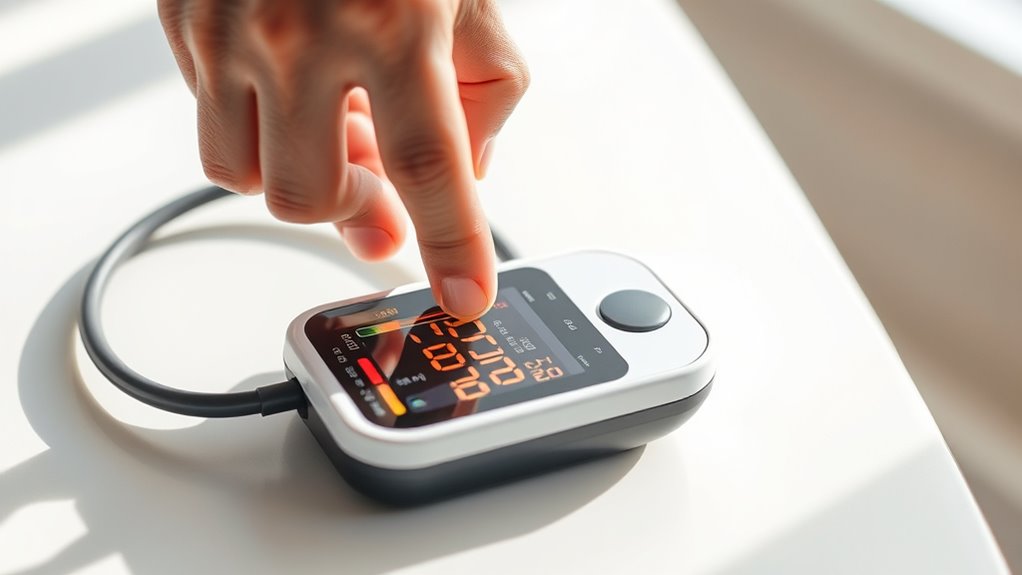To read a blood pressure monitor, you’ll look at two numbers: the systolic (top) and diastolic (bottom) values. Systolic measures pressure when your heart beats, while diastolic measures it when your heart rests. A normal reading is below 120/80 mmHg. Make sure you’re seated comfortably and relaxed when measuring. Track your results consistently to monitor changes over time. There’s more to learn about how each value impacts your health.
Understanding Blood Pressure Readings
Understanding blood pressure readings is essential for monitoring your cardiovascular health. Blood pressure is categorized into specific ranges that help you know where you stand. The normal range is typically considered to be below 120/80 mmHg. If your readings fall between 120-129 systolic and less than 80 diastolic, you’re in the elevated category. Stage 1 hypertension ranges from 130-139 systolic or 80-89 diastolic, while Stage 2 hypertension is 140 or higher systolic or 90 or higher diastolic. Being aware of these blood pressure categories empowers you to take charge of your health. Regular monitoring can lead to informed decisions and lifestyle adjustments that promote your freedom and well-being. Remember, knowledge is key!
The Systolic and Diastolic Values Explained
When you check your blood pressure, you’ll notice two numbers: the systolic and diastolic values, each providing essential insights into your heart’s health. The systolic pressure, the top number, measures the force of blood against your artery walls when your heart beats. A healthy systolic reading typically falls below 120 mmHg. The diastolic pressure, the bottom number, indicates the pressure in your arteries when your heart rests between beats. Ideally, this value should be under 80 mmHg. Together, these numbers help gauge your cardiovascular health. Understanding these readings empowers you to take control of your well-being, enabling you to make informed decisions about your lifestyle and healthcare. Always consult a professional if you have concerns about your readings.
How to Use Your Blood Pressure Monitor
To accurately measure your blood pressure, it’s essential to follow a few simple steps. First, choose the right monitor type—either digital or manual. For digital monitors, sit comfortably, place the cuff around your upper arm, and press the start button. For manual monitors, inflate the cuff using the bulb and listen for your heartbeat through the stethoscope.
Next, make sure you’re relaxed and seated with your feet flat on the ground. Avoid talking or moving during the reading. Take at least two measurements, a minute apart, to get an accurate average. Remember to use proper reading techniques, like positioning the monitor at heart level, to enhance accuracy. Keeping these steps in mind will help you effectively use your blood pressure monitor.
Interpreting Your Blood Pressure Results
After you’ve taken your blood pressure measurements, interpreting the results is key to understanding your cardiovascular health. Blood pressure categories are important for gauging your well-being. Normal readings are below 120/80 mmHg, while elevated blood pressure ranges from 120-129 systolic. Hypertension starts at 130 systolic, and it’s essential to recognize these classifications. If your readings fall into the elevated or hypertensive categories, it might be time to reflect on lifestyle changes. Incorporating regular exercise, a balanced diet, and stress management can greatly impact your blood pressure. Remember, maintaining a healthy blood pressure is crucial for your overall freedom and wellness. By staying informed and proactive, you can take control of your health and make empowered choices.
Tips for Accurate Measurements and Tracking
Guaranteeing you get accurate blood pressure measurements is crucial for tracking your health effectively. To achieve this, consider the following tips:
- Consistent Measurement Frequency: Measure your blood pressure at the same time each day to establish a reliable baseline.
- Prepare Properly: Sit quietly for at least five minutes before measuring. Avoid caffeine and smoking beforehand.
- Positioning: Keep your arm at heart level and verify the cuff fits snugly; a loose cuff can lead to inaccurate readings.
- Track Lifestyle Factors: Note any changes in diet, activity, or stress, as these can greatly impact your readings.
Frequently Asked Questions
Can Certain Medications Affect Blood Pressure Readings?
Yes, certain medications can definitely affect blood pressure readings. Medication types, like diuretics or beta-blockers, and their dosage impact your results, so it’s essential to take into account these factors when monitoring your blood pressure regularly.
How Often Should I Measure My Blood Pressure?
Measuring your blood pressure at home should feel like a daily ritual—aim for an ideal frequency of two to three times a week, or as your doctor recommends, to guarantee you stay informed and empowered.
What Factors Can Temporarily Raise Blood Pressure?
Stressful situations and certain dietary choices, like high salt intake or caffeine, can temporarily raise your blood pressure. Managing stress and making healthier food decisions can help keep your levels more stable and in check.
Are There Specific Times of Day to Measure Blood Pressure?
Measuring blood pressure is like catching the right wave; timing matters. To get accurate readings, check it during morning habits or evening routines, as these times reflect your body’s natural rhythms and daily fluctuations.
Should I Consult a Doctor if Readings Are Consistently High?
Yes, you should consult a doctor if your blood pressure readings are consistently high. It’s essential to address potential health concerns early to guarantee your well-being and maintain your freedom to live life fully.

